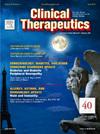单剂量替马洛尔滴眼液序贯治疗急性闭角危像的疗效和耐受性:一项双盲、随机、安慰剂对照试验。
IF 3.6
4区 医学
Q2 PHARMACOLOGY & PHARMACY
引用次数: 0
摘要
目的:观察和比较噻洛尔滴眼液序贯治疗急性闭角危象(AACC)的疗效。方法:在这项前瞻性、随机、双盲病例对照研究中,连续入组了河北大学附属医院2021年4月至2023年10月诊断为AACC的患者。收集患者资料,随机分为替马洛尔组(A组)和安慰剂组(B组)。所有患者依次接受药物治疗、前房穿刺和氩激光虹膜周围成形术。主要结果是眼压(IOP)降低、成功率和治疗时间。结果:治疗开始后2小时、4小时、6小时,A组眼压下降分别为13.87±13.85 mm Hg、28.42±12.87 mm Hg、35.69±8.51 mm Hg,控制眼数分别为23只(29.87%)、51只(66.23%)、71只(92.20%)。B组IOP降低分别为15.88±14.95 mm Hg、28.17±13.63 mm Hg、33.90±13.59 mm Hg,对照组眼数分别为30(36.59%)、58(70.73%)、75(91.46%)眼。危像缓解患者中,A组AACC缓解时间为3.29±1.31 h, b组为3.38±1.34 h。两组序期治疗各时点IOP降低、眼数缓解、AACC缓解时间差异无统计学意义(P < 0.05)。结论:在AACC序贯治疗中,替洛尔无助于提高治疗成功率。本文章由计算机程序翻译,如有差异,请以英文原文为准。
Efficacy and Tolerability of Single-Dose Timolol Eye Drops in the Sequential Treatment of Acute Angle-Closure Crisis: A Double-Blind, Randomized, Placebo-Controlled Trial
Purpose
To observe and compare the efficacy of timolol eye drops in sequential treatment of acute angle-closure crisis (AACC).
Methods
In this prospective, randomized, double-blind case-control study, patients diagnosed with AACC at the Affiliated Hospital of Hebei University from April 2021 to October 2023 were continuously enrolled. The patient data were collected and randomly divided into timolol group (group A) and placebo group (group B). All patients were sequentially treated with drug therapy, anterior chamber paracentesis, and argon laser peripheral iridoplasty. The primary outcomes were decreased intraocular pressure (IOP), success rate, and treatment time.
Findings
At 2 hours, 4 hours, and 6 hours after the start of treatment, the reduction in IOP in group A was 13.87 ± 13.85 mm Hg, 28.42 ± 12.87 mm Hg, and 35.69 ± 8.51 mm Hg, respectively, and the number of controlled eyes was 23 (29.87%), 51 (66.23%), and 71 (92.20%), respectively. The reduction in IOP in group B was 15.88 ± 14.95 mm Hg, 28.17 ± 13.63 mm Hg, and 33.90 ± 13.59 mm Hg, respectively, and the number of controlled eyes was 30 (36.59%), 58 (70.73%), and 75 (91.46%) eyes, respectively. Among patients whose crises were relieved, the times for AACC relief were 3.29 ± 1.31 hours in group A and 3.38 ± 1.34 hours in group B. There were no significant differences in IOP reduction, numbers of eyes remission, and times for AACC relief between the 2 groups at each point of sequential treatment (P > 0.05).
Implications
In the sequential treatment of AACC, timolol is not helpful to improve the success rate of treatment.
求助全文
通过发布文献求助,成功后即可免费获取论文全文。
去求助
来源期刊

Clinical therapeutics
医学-药学
CiteScore
6.00
自引率
3.10%
发文量
154
审稿时长
9 weeks
期刊介绍:
Clinical Therapeutics provides peer-reviewed, rapid publication of recent developments in drug and other therapies as well as in diagnostics, pharmacoeconomics, health policy, treatment outcomes, and innovations in drug and biologics research. In addition Clinical Therapeutics features updates on specific topics collated by expert Topic Editors. Clinical Therapeutics is read by a large international audience of scientists and clinicians in a variety of research, academic, and clinical practice settings. Articles are indexed by all major biomedical abstracting databases.
 求助内容:
求助内容: 应助结果提醒方式:
应助结果提醒方式:


